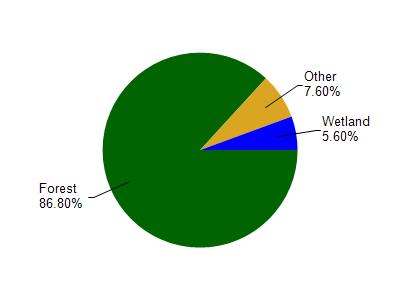
6.13 Miles
0 - 6.13
Macroinvertebrate, Coldwater
2020
Good
Bayfield
Yes
Yes
No
Fish and Aquatic Life
Overview
This cold water stream is classified as supporting a Class I brook, brown and rainbow trout fishery, and runs of migratory trout and salmon species from Lake Superior. The stream is listed as an outstanding resource water. The stream has deep pools and undercut banks, with a gravel sand and clay bottom. It empties into Vanderventer Bay on Washburn's southern edge.
During survey work conducted as part of the coastal wetlands evaluation, no rare species of macroinvertebrates were found and overall taxa richness was low (0-4 species) (Epstein 1997). Streambank erosion, silt and low flows are significant contributors to impaired habitat quality at the survey site, and livestock, barnyards and cropland are sources of pollutants with potential to affect the stream.
Date 1999
Author Aquatic Biologist
General Condition
Thompson Creek (Vandeventer) was assessed during the 2018 listing cycle; new biological (fish Index of Biotic Integrity (IBI) scores) sample data were clearly below the 2018 WisCALM listing thresholds for the Fish and Aquatic Life use. This water was meeting this designated use and was not considered impaired.
Date 2017
Author Ashley Beranek
Condition
Wisconsin has over 84,000 miles of streams, 15,000 lakes and milllions of acres of wetlands. Assessing the condition of this vast amount of water is challenging. The state's water monitoring program uses a media-based, cross-program approach to analyze water condition. An updated monitoring strategy (2015-2020) is now available. Compliance with Clean Water Act fishable, swimmable standards are located in the Executive Summary of Water Condition in 2018. See also the 'monitoring and projects' tab.
Reports
Management Goals
Wisconsin's Water Quality Standards provide qualitative and quantitative goals for waters that are protective of Fishable, Swimmable conditions [Learn more]. Waters that do not meet water quality standards are considered impaired and restoration actions are planned and carried out until the water is once again fishable and swimmable
Management goals can include creation or implementation of a Total Maximum Daily Load analysis, a Nine Key Element Plan, or other restoration work, education and outreach and more. If specific recommendations exist for this water, they will be displayed below online.
Monitoring
Monitoring the condition of a river, stream, or lake includes gathering physical, chemical, biological, and habitat data. Comprehensive studies often gather all these parameters in great detail, while lighter assessment events will involve sampling physical, chemical and biological data such as macroinvertebrates. Aquatic macroinvertebrates and fish communities integrate watershed or catchment condition, providing great insight into overall ecosystem health. Chemical and habitat parameters tell researchers more about human induced problems including contaminated runoff, point source dischargers, or habitat issues that foster or limit the potential of aquatic communities to thrive in a given area. Wisconsin's Water Monitoring Strategy was recenty updated.
Grants and Management Projects
| Project Name (Click for Details) | Year Started |
|---|
|
|
Monitoring Projects
| WBIC | Official Waterbody Name | Station ID | Station Name | Earliest Fieldwork Date | Latest Fieldwork Date | View Station | View Data |
|---|
| 2886800 | Thompson Creek | 043181 | Thompson Creek at Sth 13 At Washburn WI | 10/6/2020 | 10/6/2020 | Map | Data |
| 2886800 | Thompson Creek | 10031052 | Thompson Creek - 1/4 mile West of HWY 13 | | | Map | Data |
| 2886800 | Thompson Creek | 043200 | Thompson Creek - Thompson Creek 0599-X | 5/25/2001 | 8/21/2007 | Map | Data |
| 2886800 | Thompson Creek | 10044247 | Thompsons Creek at W. Bigelow St | 4/10/2014 | 8/8/2016 | Map | Data |
| 2886800 | Thompson Creek | 10013531 | Thompson Creek- 40 Meters Upstream Hwy 13- Station #1 | 1/1/2015 | 1/1/2015 | Map | Data |
| 2886800 | Thompson Creek | 10046313 | Phragmites Occurrence - Thompson Creek | | | Map | Data |
| 2886800 | Thompson Creek | 10000105 | Thomspon Creek - Thompson Creek 0599-X | | | Map | Data |
| 2886800 | Thompson Creek | 10046314 | Phragmites Occurrence - Thompson Creek | | | Map | Data |
| 2886800 | Thompson Creek | 10011925 | Thompson Creek At Remap 0599 | 10/12/2005 | 1/1/2015 | Map | Data |
|

Watershed Characteristics
Thompson Creek is located in the Bayfield Peninsula Southeast watershed which is 301.48 mi². Land use in the watershed is primarily forest (86.80%), wetland (5.60%) and a mix of grassland (4.10%) and other uses (3.50%). This watershed has 453.79 stream miles, 291,749.17 lake acres and 6,560.31 wetland acres.
Nonpoint Source Characteristics
This watershed is ranked Not Ranked for runoff impacts on streams, Not Available for runoff impacts on lakes and Low for runoff impacts on groundwater and therefore has an overall rank of Low. This value can be used in ranking the watershed or individual waterbodies for grant funding under state and county programs.However, all waters are affected by diffuse pollutant sources regardless of initial water quality. Applications for specific runoff projects under state or county grant programs may be pursued. For more information, go to surface water program grants.
Thompson Creek (Vandeventer) is considered a Macroinvertebrate, Coldwater under the state's Natural Community Determinations.
Natural communities (stream and lake natural communities) represent model results and DNR staff valiation processes that confirm or update predicted conditions based on flow and temperature modeling from historic and current landscape features and related variables. Predicated flow and temperatures for waters are associated predicated fish assemblages (communities). Biologists evaluate the model results against current survey data to determine if the modeled results are corect and whether biological indicators show water quaity degradation. This analysis is a core component of the state's resource management framework. Wisconsin's Riverine Natural Communities.